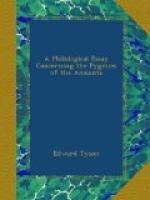Pigmy races still exist in considerable numbers in Asia and the adjacent islands, and as it was in that continent that, so far as our present knowledge goes, they had in former days their greatest extension, and, if De Quatrefages be correct, their place of origin, it will be well to deal first with the tribes of that quarter of the globe. “The Negrito” (i.e., pigmy black) “type,” says the authority whom I have just quoted, and to whom I shall have to be still further indebted,[A] “was first placed in South Asia, which it without doubt occupied alone during an indeterminate period. It is thence that its diverse representatives have radiated, and, some going east, some west, have given rise to the black populations of Melanesia and Africa. In particular, India and Indo-China first belonged to the blacks. Invasions and infiltrations of different yellow or white races have split up these Negrito populations, which formerly occupied a continuous area, and mixing with them, have profoundly altered them. The present condition of things is the final result of strifes and mixtures, the most ancient of which may be referred back to prehistoric times.” The invasions above mentioned having in the past driven many of the races from the mainland to the islands, and those which remained on the continent having undergone greater modification by crossing with taller and alien races, we may expect to find the purest Negritos amongst the tribes inhabiting the various archipelagoes situated south and east of the mainland. Amongst these, the Mincopies of the Andaman Islands offer a convenient starting-point. The knowledge which we possess of these little blacks is extensive, thanks to the labours in particular of Mr. Man[B] and Dr. Dobson,[C] which may be found in the Journal of the Anthropological Institute, and summarised in De Quatrefages’ work. The average stature of the males of this race is four feet six inches, the height of a boy of ten years of age. Like children, the head is relatively large in comparison with the stature, since it is contained seven times therein, instead of seven and a half times, as is the rule amongst most average-sized peoples. Whilst speaking of the head, it may be well to mention that these Negritos, and in greater or less measure other Negritos and Negrillos (i.e., pigmy blacks, Asiatic or African), differ in this part of the body in a most important respect from the ordinary African negro. Like him, they are black, often intensely so: like him, too, they have woolly hair arranged in tufts, but, unlike him, they have round (brachycephalic) heads instead of long (dolichocephalic); and the purer the race, the more marked is this distinction. The Mincopie has a singularly short life; for though he attains puberty at much the same age as ourselves, the twenty-second year brings him to middle life, and the fiftieth, if reached, is a period of extreme senility. Pure in race, ancient in history, and carefully studied, this race deserves some further attention here than can be extended to others with which I have to deal. The moral side of the Mincopies seems to be highly developed; the modesty of the young girls is most strict; monogamy is the rule, and—




